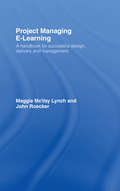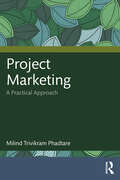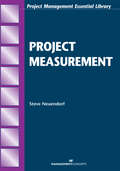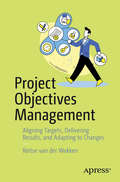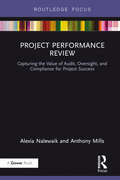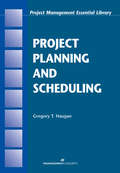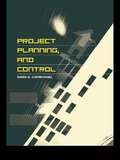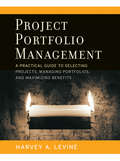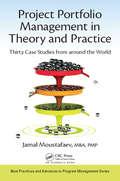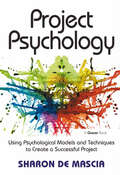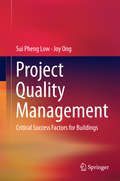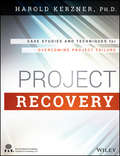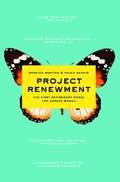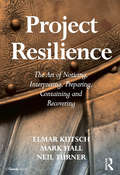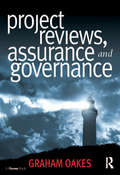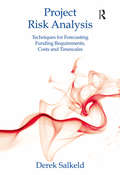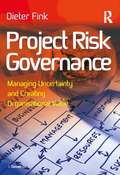- Table View
- List View
Project Manager's Spotlight on Risk Management
by Kim HeldmanClear-Cut Ways to Manage Project Risk If you're a typical project manager, you're probably aware of the importance of risk management but may not have the time or expertise to develop a full-blown plan. This book is a quick and practical guide to applying the disciplines of proven risk management practices without the rigor of complex processes. Part of the Project Manager's Spotlight series from Harbor Light Press, this straightforward book offers solutions to real-life risk scenarios. Inside, best-selling author Kim Heldman highlights critical components of risk management and equips you with tools, techniques, checklists, and templates you can put to use immediately. By following a realistic case study from start to finish, you'll see how a project manager deals with each concept. Ultimately, this book will help you anticipate, prevent, and alleviate major project risks. Project Manager's Spotlight on Risk Management teaches you how to Look for and document risk Anticipate why projects fail Prevent scope and schedule risks Analyze and prioritize risks Develop, implement, and monitor risk response plans And much more!
Project Manager's Toolkit
by David Shailer'The Project Manager's Toolkit' provides a quick reference checklist approach to drive an IT development project as well as solve issues that arise in the process. It can be used proactively to set a project on the right course and reactively for solutions to problems. It will:* help identify what needs doing next on an IT project* provide quick reference 'to-do' lists for use throughout the lifecycle of an IT project* answer the need for material that can be used to quality-check project deliverablesIt has been designed so that those on the project team who are facing a problem can pick up the book, turn to a relevant checklist and use it as a "starter-for-ten" to find a solution. For example, how to analyse data for a data-conversion exercise, or how to measure the quality of a project deliverable. 'The Project Manager's Toolkit' therefore provides a fast way to reduce an insolvable problem/issue to a set of smaller solvable ones
Project Managing E-Learning: A Handbook for Successful Design, Delivery and Management
by John Roecker Maggie McVay LynchProject Managing E-learning provides an essential framework, based on the globally accepted IPECC model, for planning, designing, delivering, managing and evaluating e-learning projects successfully. It focuses on practical, easy-to-understand methods and offers applications of project management principles in the real world. Illustrated by case studies of projects undertaken in business and academia it provides a step-by-step guide and highlights where projects typically fail. Each chapter begins with a definition and conceptualisation of the process, provides examples of how the process steps may vary dependent on organization or project size and discusses the typical problems organisations face when performing steps in the project management process. Covering all of the essentials as well as cutting-edge technology, it guides designers and managers through all stages of implementing and managing a project. Selected themes include: using focus groups gaining sponsors risk management pedagogical considerations testing quality control how to know when trouble is imminent PM software systems podcasting. The practical framework and sound advice offered in Project Managing E-learning is essential reading for all those who want to successfully implement and manage high quality e-learning in both academic and corporate training settings on time and to budget.
Project Marketing: A Practical Approach
by Milind Trivikram PhadtareThis book is a comprehensive and practical guide to project marketing – a crucial aspect of businesses worldwide. It encompasses a variety of key infrastructure projects such as roads, airports, ports, power, irrigation, commercial, and industrial buildings. The volume: • Provides key definitions and discusses concepts such as segmentation, target marketing, positioning in projects, and organizational buyer behaviour. • Draws and adapts from extant marketing theory and provides real-life case studies to demonstrate application of concepts. • Focuses on project marketing logic, marketing mix, negotiation techniques, and strategies to aid contracting/subcontracting firms to realize better pricing and project profitability. An essential handbook for professional marketers and researchers, this book will be indispensable for B-Schools, project managers, entrepreneurs, infrastructure corporations, and start-ups. It will serve as a key text to foster hassle-free relationships between different business actors and reduce roadblocks such as time and cost escalation, litigation, and the like.
Project Measurement
by Steve NeuendorfLearn how to create a measurement-oriented program for your unique organization. With new insights on measurement as a communications tool, this book offers step-by-step guidance on how to use specific quantitative actions-and-results assessments to ensure the success of key initiatives. You'll master the new skills needed to incorporate stakeholder requirements into the structure and operation of the measurement program. You'll also learn how to implement a measurement program and develop understanding of the measurement life cycle, including how to keep your tactics and processes evolving to stay in step with your organization and new challenges.
Project Moab at Hulu
by James Weber C. Fritz FoleyIn 2015, Elaine Paul, CFO of Hulu, and the rest of the senior leadership team, must decide if they should offer a new, advertisement-free subscription service. At the time Hulu distributed a wide variety of content including in season current programming and earned significant revenues from advertising revenues. This choice had strategic implications and required formulating a view on how the video on demand industry would evolve. It also had value implications that can be analyzed in a subscriber valuation model. The owners of Hulu, which included Disney and Fox, would ultimately need to approve whatever decision was made.
Project Objectives Management: Aligning Targets, Delivering Results, and Adapting to Changes
by Reitse van der WekkenManage supplier objectives effectively to align project and organizational success within your organization. This book introduces a dedicated method for suppliers to follow to ensure that all relevant targets and expectations are successfully meet. The method integrates a day-to-day high awareness, urgency, and focus on the management of all relevant objectives within the supplier’s project to provide maximum benefit for its organization. You'll learn that formal targets are routinely established at the start of a project and captured in a contract or project charter. Formal customer expectations, such as timelines, scope, and budget, have high focus and are often pitted against internal day-to-day challenges, such as cost increases and other unexpected changes. These challenges can seem even more daunting as a project progresses, especially when other stakeholders have expectations as well. When not managed properly, this can obstruct the focus of less urgent or informal objectives, such as employee development, process assets, and lessons learned, some of which provide a critical benefit for the supplier’s organization and its future. To combat this, you'll follow detailed instructions on how to handle such potential roadblocks and how to focus on achieving all relevant project objectives by applying the established method. Each chapter expands the dedicated method itself and provides insight into this philosophy. In the end you'll have all the necessary prerequisites for a successful implementation of these principles within your organization. What You Will Learn Define organizational objectives aligned with the organization’s purpose and values Prioritize and align project specific objectives with the organizational objectives Facilitate to achieve the project objectives Handle day-to-day challenges with managing the project objectives Balance customer and supplier targets and expectations Who This Book is For Project management professionals with various levels of skill and experience working at small-to-medium sized project suppliers, both for-profit and non-profit organisations.
Project Performance Review: Capturing the Value of Audit, Oversight, and Compliance for Project Success
by Alexia Nalewaik Anthony MillsProject Performance Review focuses on evaluating projects efficiently and in context, identifying important improvement opportunities and leading project and organizational management practices. It advises how these can be put in place to give stakeholders confidence in the control and delivery of their projects without waste. The authors explain not just the mechanism and objective of project performance reviews but also the ideal environment in which they are intended to be implemented. The shaping of this environment, by the stakeholders and technical team, is key to achieving your intended outcomes. Without the professional cooperation of all interested and informed parties, the effectiveness of any review may be compromised. Topics addressed include: introducing the project review method, engaging project stakeholders, ensuring project governance, conducting project risk assessments, improving accountability, providing project assurance, organizing and managing projects, optimizing review scope and approach, avoiding review pitfalls, meeting existing audit standards, and proposing alternate approaches to project evaluation.
Project Planning Techniques Book
by Parviz F. Rad Vittal S. AnantatmulaA Comprehensive Framework for Project Planning in Any Industry!Project Planning Techniques is a comprehensive reference for project managers in any discipline, outlining the latest proven-effective methods based on solid research. Blending practical experience with academic rigor, this authoritative resource will help you develop a deeper understanding of current knowledge and best practice techniques for project success.With practical examples from many industries, Project Planning Techniques gives you a firm understanding of how these methods are applied in real-world situations.• Get a solid foundation in project planning fundamentals• Discover the latest indices and models for project selection and prioritization• Gain an understanding of the schedule network and the project schedule• Learn processes and techniques for monitoring expenditures during the implementation phase• Explore the relationship between knowledge management and project management - and how you can manage project knowledge by integrating techniques from both systemsFrom start to finish, Project Planning Techniques will help you improve your understanding of project planning — and your performance as a project leader.Bonus CD-ROM: Project Planning Techniques includes a bonus CD-ROM with comprehensive examples from several industries, including WBS, RBS, network diagrams, project estimates, and much more.
Project Planning and Project Success: The 25% Solution (Best Practices In Portfolio, Program, And Project Management Ser. #15)
by Pedro SerradorProject planning is generally accepted as an important contributor to project success. However, is there research that affirms the positive impact of project planning and gives guidance on how much effort should be spent on planning? To answer these questions, this book looks at current literature and new research of this under-studied area of proj
Project Planning and Scheduling
by Gregory T. Haugan PhD, PMPThis is the only book that makes all planning methods and tools available to project managers at all levels easy to understand ... and use. Instead of applying techniques piecemeal, you'll take a cohesive, step-by-step approach to improve strategic and operational planning and scheduling throughout the organization. You'll master advanced scheduling techniques and tools such as strategic planning models and critical chain and enterprise project management. Includes time-and-error-saving checklists.
Project Planning, and Control
by David G. CarmichaelProject management is widely used in the construction industry and is central to planning and controlling time, costs and resources. This book enables readers to perform more effectively, to understand project planning and control procedures and to gain an insight into the associated skills. Numerous case examples from diverse industries and exercises support and illustrate important concepts. The result is a new perspective for project managers: planning can be shown to be a systems synthesis or an inverse problem, which provides a way to reach a satisfactory solution, avoiding the time-consuming or impractical search for the optimal solution.
Project Politics: A Systematic Approach to Managing Complex Relationships
by Nita A. MartinThe ability of individuals to work together to facilitate the delivery of a project can be a major factor in determining its success. By misinterpreting or even missing the signs of underlying political issues a project manager will struggle to deliver projects successfully. Project Politics provides a framework for solving political concerns through the effective management of complex relationships. Nita Martin's structured approach will raise awareness and improve your ability to manage issues in the workplace. She shows that once you recognize the problems, and take politics in your stride, you can successfully manage such environments. The first part of Project Politics presents theoretical concepts of human behaviour as a basis for structuring observations and understanding why people behave the way they do. The second follows the familiar project life cycle. Each project stage is considered in turn, and numerous case studies are presented with analyses that draw upon the concepts presented in Part I. Nita Martin uses psychology, influence, behaviour and communication models, gives guidance on putting theory into practice and points out typical political situations throughout. For all management professionals who recognize the importance of politics in the workplace and wish to be armed with the tools to make a difference, Project Politics will provide the foundation.
Project Portfolio Management
by Harvey A. Levine Max WidemanProject Portfolio Management (PPM) goes beyond the typical project management approach to offer a set of proven business practices that can help executives, program managers, and project managers bring projects into alignment with the strategies, resources, and executive oversight of the overall enterprise. Step by step, this book shows how to take a project from the inception of a vision to the realization of benefits to the organization. Project Portfolio Management draws on project management expert Harvey A. Levine's years of research and distills the knowledge and best practices from dozens of leaders in the field to show how to select and implement the projects that will garner the best results. Throughout this important resource, Levine tackles the many challenges associated with PPM, includingRanking value and benefitsDetermining the size of the portfolio pipelineAssessing the impact of uncertainty on projects and portfoliosUnderstanding the benefit and risk relationshipEstablishing a portfolio governance capabilityManaging the portfolio to maximize benefitsImplementing PPM
Project Portfolio Management in Theory and Practice: Thirty Case Studies from around the World (Best Practices in Portfolio, Program, and Project Management #24)
by Jamal MoustafaevEvery CEO in the world, if questioned, will always complain that there are a lot of ideas to implement, but, unfortunately, insufficient resources to accomplish them. This book provides a solution to this dilemma by supplying techniques to assess the value of projects, prioritize projects, and decide which projects to implement and which to postpone. In addition, it describes various methods of balancing project portfolios and different strategic alignment models. The book provides thirty real-life project portfolio management case studies from pharmaceutical, product development, financial, energy, telecommunications, not-for-profit and professional services industries.
Project Psychology: Using Psychological Models and Techniques to Create a Successful Project (Studies In Performance And Early Modern Drama Ser.)
by Sharon De MasciaWhy do carefully planned projects fail? Projects are affected, for good or ill, by the humans who undertake them. If the plan fails to take account of the psychology of managing people and the psychology of managing change there may be trouble ahead. Sharon De Mascia's Project Psychology uses human behaviour and emerging psychological models to provide an insight into the successful management of people in projects. By selecting the right team, facilitating a common vision and by gaining a psychological understanding of how the team and the project stakeholders interact together, a project manager improves the chance of a successful outcome. Whether you are looking to set up and manage a new project or working to develop the competence and maturity of your organization's project management capability, Project Psychology will provide you with insights and tools for making sense of the people involved and for managing them to best effect.
Project Quality Management
by Sui Pheng Low Joy OngThe book presents the development of the Construction Quality Assessment System (CONQUAS), Singapore's de facto quality performance measurement system, explains the application of the Quality Management System (QMS) to manage CONQUAS and identifies 33 critical success factors (CSFs) for achieving high CONQUAS scores. Through CONQUAS, the reader benefits from understanding how the Singapore government developed and implemented the first objective system for measuring what many building professionals have perceived to be elusive quality standards in the construction industry. The book presents both the theoretical concepts as well as the practical aspects to achieving strategic Project Quality Management that is anchored on the CSFs to building best practices. To realistically reflect the practical aspects and challenging issues faced by stakeholders in the construction industry, questionnaire surveys were conducted with building professionals to distinguish the importance level and extent of adoption of the 33 CSFs (identified from a comprehensive review of the extant literature) in influencing and affecting the achievement of high CONQUAS scores. These were further anchored by in-depth interviews with quality experts in the Singapore construction industry to provide a better understanding of issues relating to strategic Project Quality Management. Collectively, the empirical findings collated from the building professionals suggest that while the CSFs identified are known tenets of quality, these were still not being followed in their totality. A further case study was conducted through a formal set of in-depth interviews with the quality assurance team of a construction company who has direct involvement before, during and after their tremendous improvements in the CONQUAS scores attained. The strength of this book therefore represents a true account and reflections of real-life practices and experiences in the construction industry for contractors, quality managers and policy-makers to learn from. Although the context of this book relates to the Singapore experience, the lessons and recommendations are equally relevant and applicable to the global construction industry in both the developing and developed countries whose stakeholders (in both the public and private sectors) wish to understand how CONQUAS works, and how the CSFs identified can likewise be implemented for strategic Project Quality Management to building best practices. The book is therefore of interests to researchers, academia and practitioners in the construction industry as well as in other sectors of the economy (in Singapore and other countries) where learning points may be used for enhancing project quality management for buildings.
Project Recovery: Case Studies and Techniques for Overcoming Project Failure
by Harold KerznerBest practices for picking up the pieces when projects fail There are plenty of books available offering best practices that help you keep your projects on track, but offer guidance on what to do when the worst has already happened. Some studies show that more than half of all large-scale project fail either fail completely, or at least miss targeted budget and scheduling goals. These failures cost organizations time, money, and labor. Project Recovery offers wise guidance and real-world best practices for saving failed projects and recovering as much value as possible from the wreckage. Since failing project cannot be managed using the same lifecycle phases employed with succeeding projects, most project management professionals are unprepared to tackle the challenge of project recovery. This book presents valuable case studies and a recovery project lifecycle to help project managers identify and respond effectively to a troubled project. Includes case studies and best practices for saving failing projects or recovering projects that have already failed Written by experience project manager Howard Kerzner, the author of Project Management Best Practices, Third Edition Features proven techniques for performing project health checks and determining the degree of failure and the recovery options available Includes a new recovery lifecycle that includes phases and checklists for turning around failing projects With comprehensive case studies, checklists, worksheets, and cross listings to the appropriate project management body of knowledge, Project Recovery offers a much needed lifeline for managers facing the specter of failure.
Project Renewment
by Bernice Bratter Helen Dennis Lahni BaruckFor the first time in history, career women -- women who have worked outside the home for most of their lives -- are retiring. Without role models, they look to one another to face the changes this life transition brings. Career women from the Baby Boom and pre-Baby Boom, or Silent, generations are approaching retirement. They want to know what it means to suddenly find themselves back inside their homes after having devoted their lives to careers outside of them. These women are highly skilled, educated and successful.They have achieved visibility, status and influence. And because they are the first large group of American women to define themselves by their work, they have few, if any, models for retirement. Project Renewment will show women that giving up their careers does not mean giving up who they are. Renewment is a term the authors created as an alternative to the word retirement, which they associated with negative stereotypes and clichés. A combination of retirement and renewal, Renewment suggests optimism and opportunity, growth and self-discovery. Project Renewment is a grassroots movement among women who are close to retirement or recently retired and looking to connect with one another. The women of Project Renewment believe that retiring is a process of change and increasing self-awareness. As they redirect the commitment and passion previously dedicated to their careers, they transform and reshape their lives. Project Renewment provides these women with an enriched and safe environment in which to explore and confront the challenges that lie ahead as they leave behind a lifetime at the office, hospital, studio or courtroom. Diverse topics are discussed, such as Who am I without my business card? What if he retires first? What is productivity anyway? Why do I feel guilty reading a book on a Tuesday afternoon? How do I feel about not earning another dollar? Divided into two sections, Project Renewment offers insight and support in a friendly, humorous and meaningful way. The first part of the book addresses the challenges that career women tackle when looking to retire. The second teaches readers how to start and maintain their own Project Renewment group, so they can find support, inspiring relationships and even a few laughs as they look to get the most out of the rest of their lives.
Project Requirements: A Guide to Best Practices
by Ralph R. YoungProject Requirements: A Guide to Best Practices gives project managers tools they can assimilate and apply easily to improve project success rates, reduce development costs, reduce rework, and accelerate time to market. Based on experience and best practices, this valuable reference will help you:• Clarify real requirements before you initiate project work• Improve management of project requirements• Save time and effort• Manage to your schedule• Improve the quality of deliverables• Increase customer satisfaction and drive repeat businessProject Requirements: A Guide to Best Practices provides project managers with a direct, practical strategy to overcome requirements challenges and manage requirements successfully.
Project Resilience: The Art of Noticing, Interpreting, Preparing, Containing and Recovering
by Mark Hall Elmar KutschAs the title suggests, Project Resilience is about making projects and project managers more resilient. The authors look at projects not simply from a ’mechanistic’ approach in which work can be broken down, executed and controlled as a series of interlocking parts but rather as ’organic’ constructs, living entities existing for a finite period of time, consisting of people, structures and processes. These entities are constantly challenged by environmental adversity - risk, uncertainty and complexity. Resilience involves finding ways to help project managers notice more, interpret adversity more realistically, prepare themselves better for it, contain and recover from it quicker and more appropriately. <P><P> The book has two purposes: it offers a glimpse into our tendencies to be irrational in the face of adversity: risk, uncertainty and complexity. The second purpose is to offer a new perspective to aid in managing risky, and in particular uncertain and complex projects. The authors go beyond commonly-accepted standards in project management with the aim of providing an understanding of how to implement project-wide resilience. The purpose is to guide, not to prescribe. It is best used as a trigger for a thinking process to define your own unique approach to managing uncertainty, not to replace your experience and judgement. Ultimately, it has been written to challenge traditional wisdom in project management, and to address the rationale for creative best practices.
Project Restart: Deciding the Future of English Football
by Deepak Malhotra Nour KteilyIn March 2020, the English Premier League football (soccer) season was suspended partway through due to the COVID-19 pandemic. Two months later the season remained in limbo, with a looming deadline to decide whether to attempt to complete the season or curtail it-and if so, how. These decisions had major implications for a number of key stakeholders, each with their own incentive structures. One key point of contention was whether to temporarily cancel the system of relegation (i.e., demotion) from the league for the bottom teams. This case investigates the process by which a decision was reached, considering the role of historical and social context in shaping the eventual conclusion.
Project Reviews, Assurance and Governance
by Graham OakesProjects are hard. By definition, projects are about non-routine activities. Many of them are large and complex; they may involve many people, often from different backgrounds and increasingly with different languages and cultures. Amongst all of this, it is easy to get lost, to overlook important trends or to misunderstand each other. So projects fail. Graham Oakes' Project Reviews, Assurance and Governance is about learning from your mistakes and understanding what's really going on with your projects. In order for reviews and assurance to provide you with this information and learning, you need to perform them effectively and that is the purpose of this book. The core of the book is built around a number of models of project review processes and governance, all derived from practice and interspersed with case studies drawn from practitioners, project management literature and from practices in other industry. The result is the blend of the conceptual and the practical needed to make your project assurance process sympathetic, relevant and rigorous for your organization and the range of projects and programmes which you undertake.
Project Risk Analysis: Techniques for Forecasting Funding Requirements, Costs and Timescales
by Derek SalkeldProjects overspend and overrun. Business cases perform less well than expected. Managers tighten their grip and initiate more procedure. But little changes and the scenario repeats, and it has done so for decades. Losing other peoples' money and goodwill is almost an innate characteristic of projects. This may be a norm but it need not be the natural state of affairs. In Project Risk Analysis, Derek Salkeld shows how easily assimilated techniques developed out of formal risk analysis methods can be used to increase the chances of projects being delivered to the oft quoted objective of on time and to budget, to quality and to popular acceptance. These techniques need to be understood by managers so that they can foresee the benefits of directing their teams to carry them out, and so they can inform their clients about the potential consequences of the investments they wish to make and how the project team plan to assure these. The three parts of the book explain how you can: ¢ calculate the funding required for a simple, short project using risk based methods to generate answers that are more accurate than traditional estimating ¢ apply the techniques to inform an investment decision for a major project, taking into account whole of life costs, operations and revenues ¢ design and implement specific management controls that will assure the outcomes of the investment decisions. Risk and opportunity are inherent in projects and yet, whilst many organizations invest heavily in project management methodologies and processes, few project sponsors, project board members or managers understand the effect these might have. The approach taken in the book is to understand how the risk and opportunity in a project will affect its funding requirements and its business case outcomes, and to use this understanding to devise management controls that will benefit both the investor and the project manager. This is essential reading for anyone concerned with adding value to projects, programmes and the organizations for which they are delivering them.
Project Risk Governance: Managing Uncertainty and Creating Organisational Value
by Dieter FinkIn Project Risk Governance, Dieter Fink breaks new ground in two ways. Firstly, he places project risk management in the context of today’s organisations in which objectives are increasingly implemented through projects to better respond to fast-changing markets. Secondly, he applies a governance perspective to examine project risk at the project and corporate levels, an approach which is significantly under-researched and for which theoretical knowledge and professional practice are at an early stage of maturity. Project risk governance falls between corporate governance and project governance and is attracting increasing attention. The author argues that there are two reasons for this. The first is the ’projectisation’ of organisations, in particular within organisations conforming to the Project-Based Organisation (PBO) model. The second is the prevalence of a strategic approach to managing risk for the purposes of protecting organisational values and creating competitive advantage. The book addresses governance, strategy, value management and building enterprise-wide Project Risk Governance (PRG) capabilities. Chapters examine the role of projects in organisations and the need to integrate project and business strategy within the framework of the Project-Based Organisation. PRG is introduced via its links with corporate and project governance and its scope is covered in chapters that identify relevant processes, structures and relationship mechanisms. Contextual influences such as the professionalisation of project management are recognised and insights provided to increase readers’ understanding of uncertainty, risk events, and probabilities and of the essential requirements of managing risks at project level. The final chapter provides a roadmap to the stages and dimensions of a PRG maturity model.


